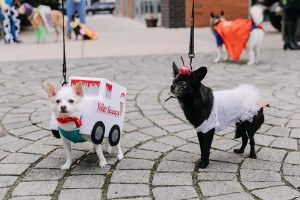No, Spotted Lanternflies Are Not Hiding in Your Soon-to-Be-Christmas Tree
Risk of the invasive bug hitching a ride into your home is minimal, experts say. The holidays are saved.

L: The spotted lanternfly, courtesy of the USDA | Christmas trees via Getty Images
I, like so many others, find it necessary to usher in the holidays by picking out a good ol’ Christmas tree and plopping it in a watering basin in my living room. It’s a surefire way to get into the festive spirit — and a live tree fills your home with that fresh forest smell, after all. So this past weekend, I was dismayed when my equally holiday-crazed roommate told me she might not want to get a live tree.
Why? Because of spotted lanternflies.
My roommate fell prey to a spreading rumor that the dreaded invasive insects are infesting Christmas trees and ruining the holidays.
It will lay. eggs. in. my. house. Christmas is cancelled.
— Erin A. Hennessy (@ErinAHennessy) November 18, 2019
But alas, after some frenzied digging, I’m happy to inform you that this rumor is false: Agricultural experts at Penn State Extension reported this week that the risk of a spotted lanternfly hitching a ride indoors on your Christmas tree is “minimal.”
While real trees are “part of an outdoor ecosystem, and there is always a chance that insects may be brought indoors with a tree, and the spotted lanternfly is no exception,” horticulture educator Tanner Delvalle said in a statement on Monday, “Christmas trees are not a preferred host for spotted lanternflies, so the probability of finding a spotted lanternfly or an egg mass on Christmas trees is low and should not be a reason for anyone to forego having a live holiday tree.”
Everyone can now relax.
Norm Schultz runs Linvilla Orchards, which conducts a huge pick-your-own-Christmas-tree operation each year. He said he’s yet to see a single spotted lanternfly on any of the orchard’s holiday trees. (The bugs have, however, invaded other plants on Linvilla property, like the invasive Tree of Heaven — the bug’s host of choice — and grape vines.)
Linvilla is home to more than 40,000 Christmas trees and is located in Delaware County, one of 14 Pennsylvania counties listed in the spotted lanternfly quarantine zone. (Philly is, too.) Schultz said the orchard is working with the United States Department of Agriculture to eradicate the insects, which pose a threat to the state’s $18 billion agriculture industry. But he’s not at all concerned about Christmas trees.
“We can say with certainty — 100 percent, from the research I’ve seen — that they don’t feed on Christmas trees,” Schultz said. “And we, 100 percent, have never seen them on our [Christmas] trees. We can’t figure out how this rumor started. But it’s all over social media, so look out.”
As for where the gossip originated (or at least one reason it spread), we’ve got an idea.
A Ravenous Creature The Spotted Lanternfly, Now Spotted In New York Too. Safety Concerns Continue to Grow About Live Christmas Trees Lotshttps://t.co/xry7Kk9Z19
#America #bug #BUGS #business #celebration #christmas #ChristmasLights #christmastree #eventplanning#forsale pic.twitter.com/joqVbv9xli— Team Santa Inc (@TeamSanta) October 24, 2018
E-commerce business Team Santa Inc., which happens to sell “over 2,500 prelit, big, table top, potted, upside down, potted and colorful” artificial Christmas trees, tweeted out a PSA about “ravenous” spotted lanterflies on live Christmas trees last year. (Oh, and U.S. Sen. Chuck Schumer of New York might have something to do with it, too.)
Now that the rumor is quashed, rest assured that you should be safe to buy a Christmas tree this year. If you want to be extra careful, check your tree for any bugs or egg sacs (which experts say can look like putty or a wad of chewing gum) before you bring it inside. If you do see eggs, be sure to scrape them into a plastic bag with alcohol before disposing of them. And read more about spotted lanternflies here.
FYI, there is one way you might actually want to bring a spotted lanternfly into your home: in ornament form. (We sense a new business opportunity for Team Santa Inc.)


